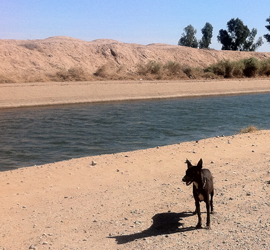Coyotes and Stray Dogs Are Focus of Leafy Greens Study
Chris Brunner, November 22, 2014
Rich soil, water access and abundant sunshine in Yuma, Arizona, make it the nation’s largest leafy green vegetable producer. The desert southwest provides 90% of the nation’s leafy vegetables between November and March. Yuma is the winter vegetable capital of the world.
In 2010 an E. coli O145:H28 outbreak tied to bagged Romaine lettuce, sickened at least 30 people in 5 states. Three patients developed a type of kidney failure known as hemolytic uremic syndrome, or HUS. No deaths were reported. Investigations linked the outbreak to shredded Romaine lettuce from a single processing facility in the Yuma area. Several potential sources for the E. coli were evaluated but the exact source was not determined.
Food safety research projects underway since the outbreak are helping answer questions faced by the leafy greens industry. The correlation between animal defection in vegetable fields and potential E. coli infection remains a concern.
Dr. Michele Jay-Russell, program manager at the Western Center for Food Safety, (WCFS), and liaison to the Western Institute for Food Safety and Security, (WIFSS), has published a manuscript in the journal of PLOS ONE. The study, “Prevalence and characterization of Escherichia coli and Salmonella strains isolated from stray dog and coyote feces in a major leafy greens production region at the United States-Mexico border,” helps address a concern of local vegetable growers, who feel that coyotes and unleashed stray dogs are a significant problem due to intrusions into their crop fields.
The study was funded as a Center for Produce Safety “Rapid Response Project,” Findings from the research conducted by Dr. Jay-Russell and co-researchers Alexis Hake, Yingjia Bengson, Anyarat Thiptara and Tran Nguyen, and industry partners, suggest that stray dogs and coyotes in the southwest desert may not be significant sources of toxigenic E. coli, but are potential reservoirs of other pathogenic E. coli and Salmonella.
Dr. Jay-Russell proposes, “These results show the importance of food safety practices used by growers to protect vegetable crops from bacterial contamination due to animal hazards in the fields.”
Jay-Russell and her research team will soon complete a second study that will help identify domestic and wildlife animal reservoirs of shiga toxin-producing E. coli (STEC) and Salmonella in the desert southwest growing region of the U.S. and northern Mexico. In addition, it will identify management and risk mitigation practices that reduce contamination of leafy greens by these species. These findings will be published following the New Year.

